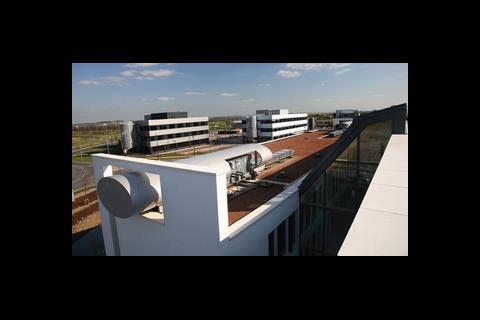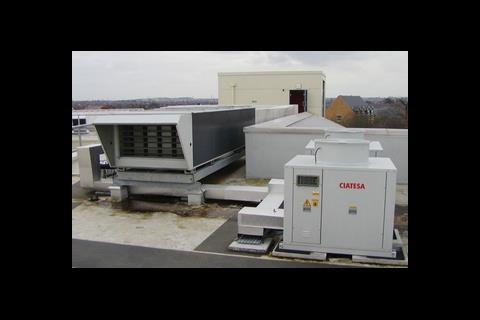The introduction of mandatory AHU inspections is good news all round, says Hywel Davies ŌĆō for carbon reduction; for building ownersŌĆÖ costs; and for services consultants in a downturn
The energy a building consumes for air-conditioning can amount to as much as a third of its annual energy cost. Older, oversized and poorly maintained air-conditioning units use more energy and cost more to operate than necessary. Regular maintenance checks, along with the compulsory inspections introduced by the Energy Performance in ║├╔½Ž╚╔·TVs Regulations will help ensure an air-conditioning system is operating as efficiently as possible.
The inspections are being introduced by government as part of the implementation of the Energy Performance of ║├╔½Ž╚╔·TVs Directive in England and Wales, with the aim of providing building owners and operators with essential information about the energy performance of their systems. The information and advice will highlight potential measures that could be taken to improve the energy efficiency and reduce the electricity consumption, operating costs and carbon emissions of the system.
Simon Barnes, head of EPBD Implementation for Communities and Local Government, said: ŌĆ£Air-conditioning inspections play an important role in helping the UK to reduce its carbon emissions. They are being introduced as part of a wider strategy, which includes energy performance certificates.
ŌĆ£The inspection report will give businesses the opportunity to develop and implement changes that will reduce energy consumption and costs.ŌĆØ
Over the next two years, mandatory inspections are being introduced for all air-conditioning systems with rated cooling output greater than 12kW. This includes the combined output of one or more individual air-conditioning units in a building if they are controlled by the same owner or tenant. Air-conditioning systems with a rated output greater than 250kW must have had an inspection by 4 January 2009.
For systems with a rated output greater than 12kW, but less than 250kW, the first inspection must be completed by 4 January 2011. Thereafter, inspections will be required every five years. For new systems installed on or after 1 January 2008, the first inspection must have taken place within five years of installation.
What does an inspection involve?
To conduct an inspection, you would be required to visit the site where the system is installed and carry out a visual assessment of the unit, examining all of the equipment, air movement systems and controls. Following the inspection, you need to provide a written report containing:
- the current efficiency of the equipment and suggestions for improvement
- a list of any faults identified during the inspection and suggested actions
- the adequacy of the equipment maintenance and suggestions for improvement
- the adequacy of installed controls and settings and suggestions for improvement
- the current size of the installed system in relation to the cooling load and suggestions for improving its energy efficiency, or, where appropriate, minimising or avoiding the need for air-conditioning.
What is the value of the inspections?
While it is too early to judge the impact of inspections, it is clear from the work of the first group of accredited assessors that there are many systems waiting to be relieved from a state of semi neglect. This is almost certain to mean a reduction in the energy used by many of the systems inspected.
Early assessments have indicated potential for very considerable gains to the environment (and the building ownersŌĆÖ pockets!) within a year or two of the inspection, with potential savings significantly greater than the cost of the inspection fee. This reinforces the case that these inspections are offering benefits to owners, not imposing further costs on them.
After conducting an inspection on the Tower of LondonŌĆÖs air-conditioning system, Darren Jones, principal consultant at Efficient Air, said: ŌĆ£Assessing a building which is as old and iconic as the Tower of London was really interesting. However, we found quite a few areas, such as improving control strategies and providing recommendations on air delivery systems and refrigeration equipment, where we were able to advise and help the team to see where they can make changes that will result in a big difference to their energy efficiency, and save money on their bills.ŌĆØ
Can I become an assessor?
Tens of thousands of complex air-conditioning systems need to be inspected ahead of the legal deadline of 4 January 2009. Several hundred thousand smaller systems will need to be inspected in the subsequent two years. These inspections need to be carried out by a skilled and experienced assessor who belongs to an approved accreditation scheme. If you want to become a qualified air-conditioning assessor, you must first become a member of an accreditation scheme ŌĆō currently there are seven. National Occupational Standards have been developed to define the skills and knowledge required to practise competently as an assessor.
To become accredited, you need to provide details of training, qualifications and work experience and be assessed against the requirements of the Approved Prior Experiential Learning (APEL) route. This sets out to establish that applicants have a good knowledge of the operation and maintenance of air-conditioning systems and are able to assess the system capacity against the cooling load, as required to complete an inspection.
Once the APEL application is approved, provisional accreditation will be granted. From here, you must complete three air-conditioning inspections and submit the reports for assessment. Upon approval of these reports, full accreditation will be granted.
Additionally, a one-day course is available for those who wish to take the appropriate training on the requirements of the Energy Performance in ║├╔½Ž╚╔·TVs Regulations ŌĆō as they relate to air-conditioning inspections ŌĆō and on the available industry agreed guidance, such as CIBSE TM44. Once accredited, you will be added to a register of Energy Assessors and may begin conducting inspections. While this process may take time, for those with skills, knowledge and experience the route is straightforward.
Is it worth being an inspector?
Given the numbers of systems that require inspection, there is undoubtedly a workload for suitably skilled individuals. Recent industry reports have highlighted concerns that activity in the sector may be decreasing, so the ability to add this facility to the range of services provided to clients should be welcome.
In addition, many systems will need to be checked regularly under the F-Gas Regulations, to ensure that they are not leaking. And with ever tightening restrictions on the range of refrigerants that may be used, there is likely to be a market for the skills to maintain, operate and inspect these systems efficiently for some time ahead. Now is a very good time to be considering getting accredited to enter this market.
For more information visit or
Source
║├╔½Ž╚╔·TV Sustainable Design
Postscript
Hywel Davies is technical director at CIBSE

























No comments yet